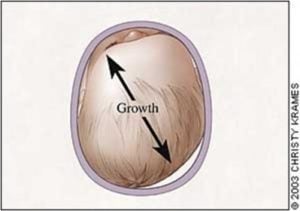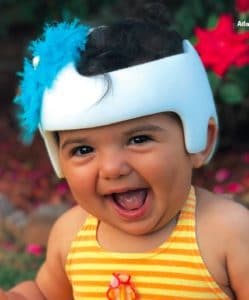How to fix a mild plagiocephaly?
Craniosynostosis is a rare genetic defect that causes the plates of an infant’s skull to fuse prematurely.
Your pediatrician will monitor your baby’s growth and development (including the shape of his or her head), assist you, and offer advice on reversing the flattening (called “positioning therapy”).
If mild plagiocephaly is not corrected by 4 months of age, the doctor may recommend a helmet for plagiocephaly and help the baby’s head return to a normal shape.
What is the treatment for a baby with mild plagiocephaly?
- Reducing pressure in the skull is the most common treatment for flat head syndrome. It consists of placing a blanket or towel on the floor and putting the baby on his tummy while he is awake for a few minutes, ideally for at least 30 minutes total each day, always under supervision.
- As your baby bobs and moves to try to lift his head, he is developing stronger muscles in his neck and shoulders. You’re also giving the back of your head a break from the pressure of lying down, which can prevent or help reverse plagiocephaly.
- Never leave your baby unsupervised during tummy time, even if he is not yet crawling, you must watch closely to make sure he does not tire himself out and hit his face on the floor.
- Another treatment if your baby’s head is flatter on one side or the other is to shift from side to side while sleeping. One way is to simply move your head from one end of the crib to the other during periods of rest.
- The Tummy time guideis an interesting guide that can help you prevent mild, moderate or severe plagiocephaly.
Treatment of plagiocephaly
If your baby is between 4 and 18 months old, the best treatment for plagiocephaly is a dynamic head band (cranial orthosis).
The treatment consists of using a custom-made orthopedic helmet to take advantage of the growth of the head and thus correct the deformity.
- the hull exerts a restraint on prominent areas
- so that the head grows through the unrestrained parts free of restraint

This treatment is possible thanks to the fact that skull fontanelles are more or less open during the first 2 years of life fontanelles of the skull are more or less open during the first 2 years of life, enough to be able to remodel the lost shape. It is therefore advisable to treat it as soon as possible.
Not all helmets are the same
Not all helmets for the treatment of plagiocephaly and other cranial deformities are the same.
Doc Band® is the only orthopedic helmet with scientific studies proving its effectiveness.
Here you can find them:
- Helmet treatment of infants with deformational brachycephaly
- Treatment of positional plagiocephaly with dynamic orthotic cranioplasty
- Treatment of craniofacial asymmetry with dynamic orthotic cranioplasty.
In addition, Dr. Pinyot and his medical team has more than 35 years of experience and has treated more than4,000 cases of cranial deformities.

With the use of the DOC Band® dynamic orthopedic helmet the treatment of plagiocephaly is easy, safe and comfortable for your child. This helmet has enabled the recovery of more than 300,000 babies worldwide.
Learn more about plagiocephaly treatment.
See the results.
Incidence of plagiocephaly
According to Aliyah Mawji, RN, of the Canadian Pediatric Society, in her article “The incidence of positional plagiocephaly : a cohort study.” published in the American Academy of Pediatrics.
“The incidence of plagiocephaly in infants aged 7 to 12 weeks has been estimated at 46.6 %. Of the total number of infants with plagiocephaly, 63.2 % were affected on the right side and 78.3 % had a moderate form. “
If you are not sure whether your baby has plagiocephaly, this guide may help you to assessing whether your baby has plagiocephaly or another cranial malformation.

What causes infant flat head syndrome?
Babies’ heads are very malleable, so anything that puts pressure on the skull can cause mild Plagiocephaly. Twins and other multiples and babies who are large for their gestational age are especially prone to be born with plagiocephaly due to the extra pressure they experience during their journey through the birth canal. The most common causes of the condition include:
- Putting the baby to sleep on their back on a firm mattress, which puts pressure on the back of the head
- The pressure exerted on the skull during childbirth
- Assisted delivery devices such as vacuums or forceps, which can reshape the skull
The prevention is perhaps the best treatment. We invite you to read this page with more information about the prevention and causes of plagiocephaly. causes of plagiocephaly.
For more information about plagiocephaly therapies treatment plagiocephaly treatment, the extensive professional experience of our team (more than 35 years), or any information about the therapies we offer. cranial malformationsplease do not hesitate to contact our centers.

